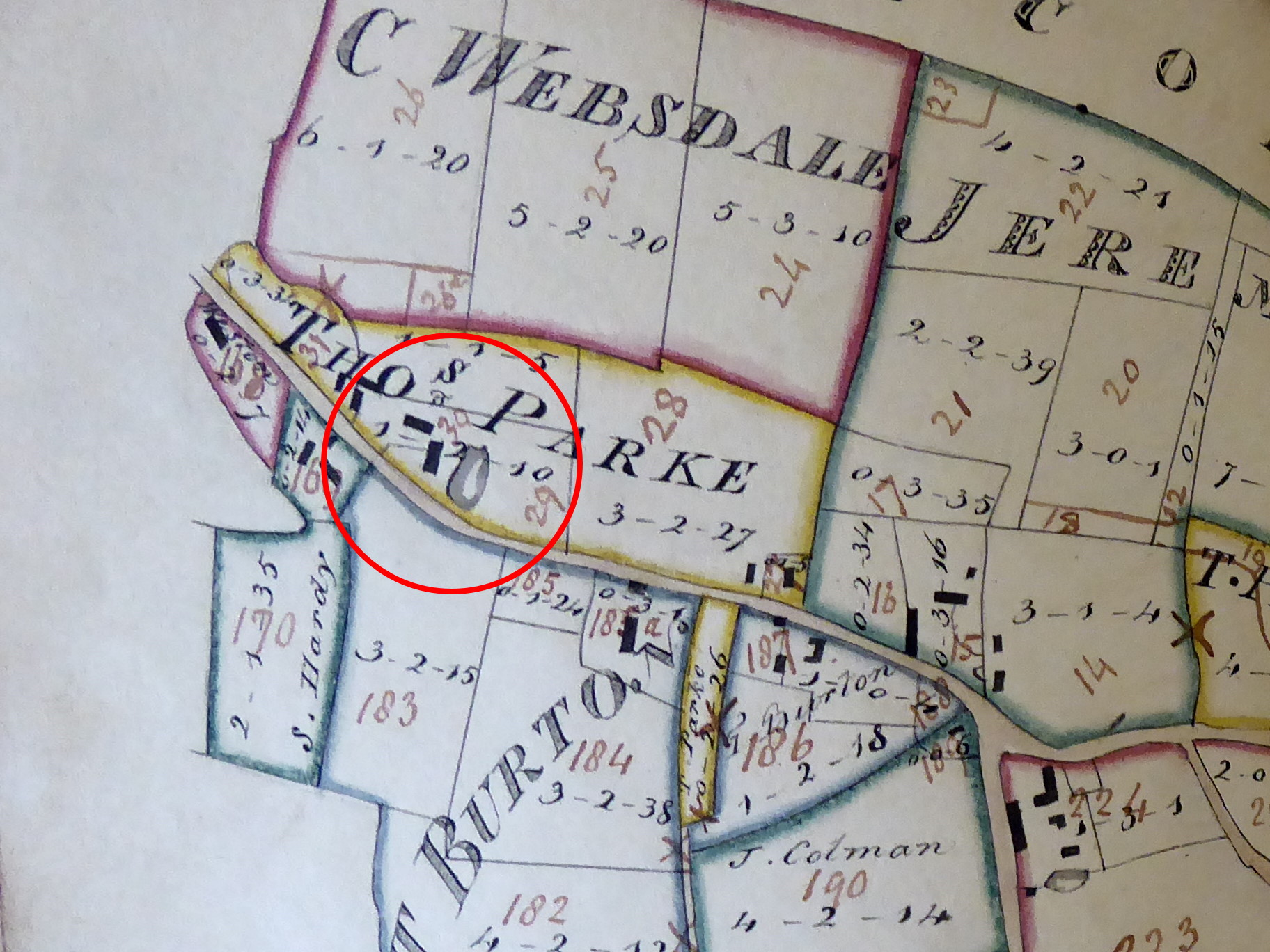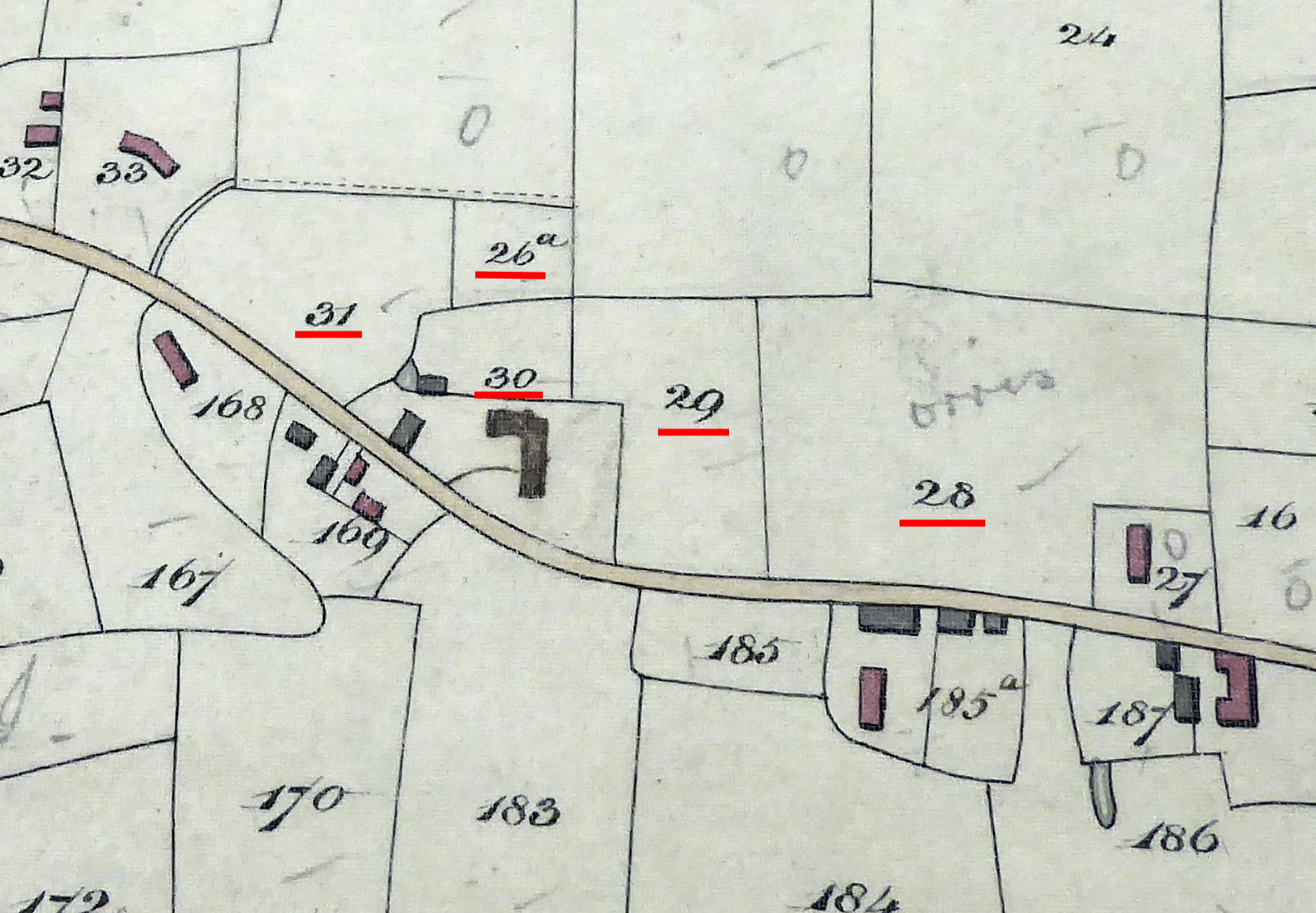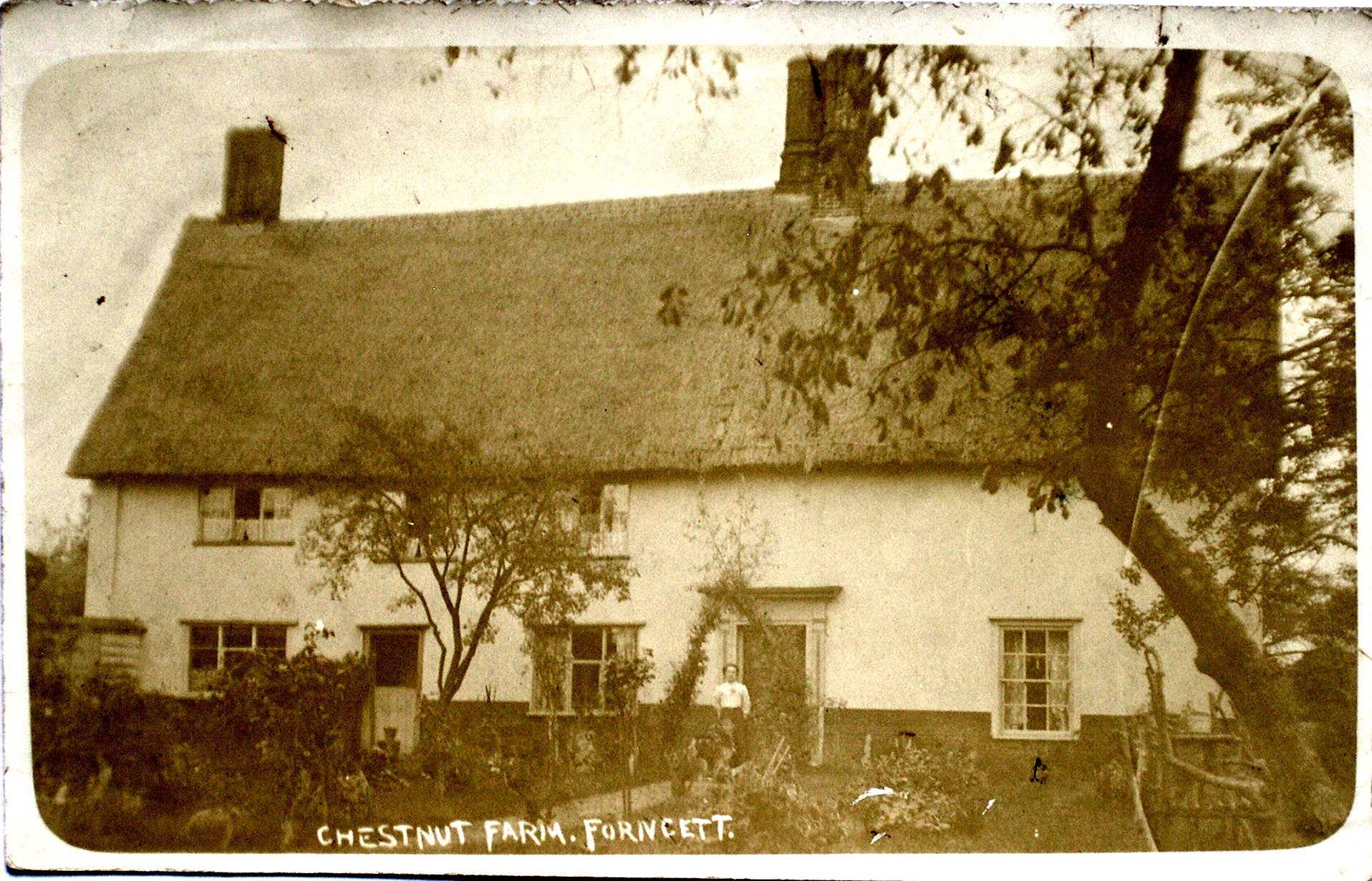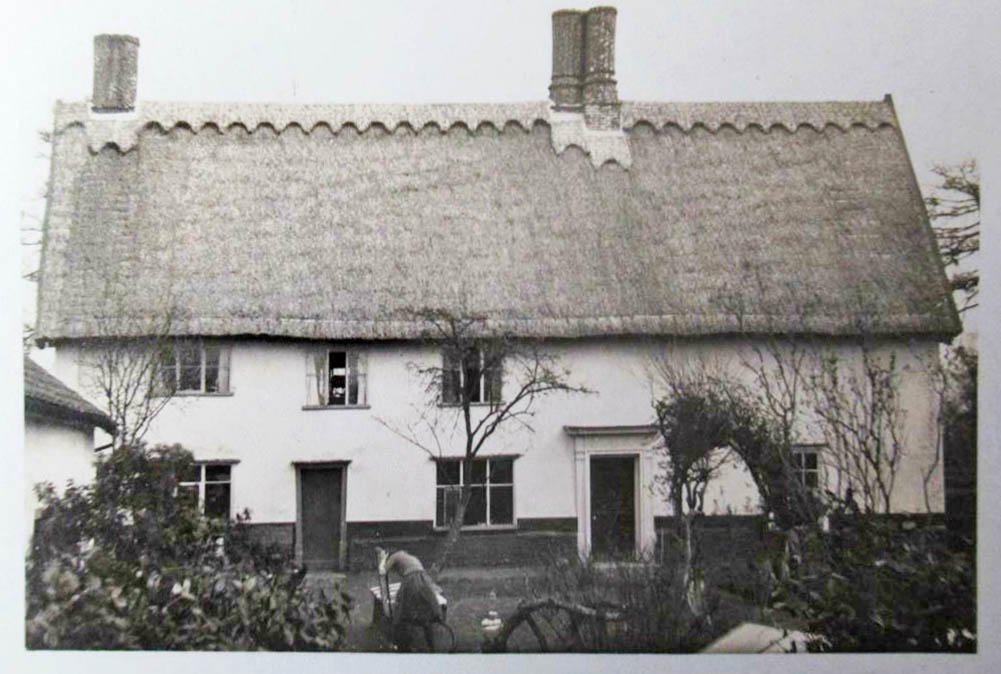
Chestnut Tree Farm - Forncett End
Chestnut Tree farmhouse is undoubtedly one of the oldest houses in Forncett. The house, which was built in the late medieval period, sat inside a medieval moat, part of which still exists as a large pond to the east of the house. The timber-framed house is thought to be a late medieval hall house and the original frame probably dates to around 1500. A floor was inserted in the 17th century, at which time two chimneys were added, one to service a kitchen, the other to provide two 'parlour' type fireplaces in the hall and the parlour. There are wall paintings on one of the chimneys.
The early owners of Chestnut Farm are difficult to trace,
but the 1817 map of Forncett shows that the farmhouse was owned at that time by
Thomas Parke who was a major landowner in Forncett.

Thomas Parke died on 28th November 1825, and in 1839 the tithe map for Forncett shows that the farmhouse was then owned by John Palmer, the son of Thomas Palmer snr. who owned Corner Farm in Forncett End. So, between them Thomas and John Palmer owned nearly 200 acres of land in Forncett.

1839 tithe map showing John Palmer's land surrounding Chestnut Tree farmhouse
John Palmer was born in Bunwell in 1794, and in 1818 he married Jane Betts from Forncett St Peter. The couple lived in Welbourne, near Mattishall, where they had four daughters and a son, Thomas, before Jane died in 1832. Thomas Palmer jnr. later took over Corner Farm in Fornett End from his grandfather.
John Palmer remarried in 1839 and his new wife was Martha Parke, the second daughter of Thomas Parke. It was almost certainly this marriage that led to John Palmer being listed as the owner and occupier of Chestnut Tree farm on the 1839 tithe map. However, John Palmer appears to have been an "absentee landlord" as he and Martha continued to live in Welbourne. It is possible that the farm was being run by Thomas Parke's elder daughter, Mary and her husband George Betts. In 1841 they were certainly living in Forncett End and George was a farmer.
When John Palmer died (aged 53) in 1847, his wife Martha moved back live at Chestnut Tree farmhouse and in the 1851 census she was running the farm of 70 acres and employing two men. Martha ran the farm until at least 1861, but in the following years both her children married into the Colman family who ran Lime Tree Farm (then known as Home Farm). In 1862, her daughter Martha married Lester Colman, and in 1863 her son William married Harriet Colman.
William and Harriet took over Chestnut Tree Farm, and in 1871 they were living there with their three children (Emma 5, Harriet 3, and Thomas 1) and William was farming 310 acres and employing 12 men and 4 boys. William's half-brother, Thomas, had retired from farming in 1867 and had moved to live at Austhorpe House. So, it would appear that William was then running Chestnut Tree Farm and Corner Farm. William's mother, Martha, had also retired and she was living with her daughter and son-in-law, Lester and Martha Colman, at Heath Farm in Winfarthing.
Somewhat surprisingly, William Palmer and his wife, Harriet, didn't stay at Chestnut Tree farm, and ten years later, in 1881, they were farming on Norwich Road, in Wymondham. It seems that Thomas Palmer had "taken back control" of his farming interests, which would have left his half-brother, William, without a job. Chestnut Tree farmhouse was once again occupied by Martha Palmer (née Parke) together with her daughter Martha and her son-in-law, Lester who appears to have given up farming and was now a coal merchant. Shortly afterwards, in 1883, Thomas Palmer suffered a severe stroke and handed over the management of all his estate to his brother-in-law, Edward Betts.

Early photograph of Chestnut Tree Farm - date unknown
Martha Palmer died in November 1890, and Lester and Martha Colman left Forncett to live in Flitcham near Sandringham. So, in 1891 a new tenant farmer, James Stimpson, aged 37, from Wacton, was in residence at Chestnut Tree farm with his wife, Julia, and their seven children. Ten years later, in 1901, the farm was occupied by another tenant, William Knott, aged 67, from Watton, together with his wife and three adult children. Knott had been a groom and a coachman all his life and when he came to Forncett he worked as a carrier as well as a farmer.
When Thomas Palmer died in 1903 the major beneficiary of his
will was his brother-in-law, Edward Betts. The will was strongly disputed by Thomas's
half-brother, William, who lost his case in court! So, in 1905, when the
dispute over the will had finally been resolved, much of Thomas Palmer's estate
was sold off by Edward Betts. In the Norfolk News report of the auction on
5th August, Chestnut Tree farm appeared as Lot 5 (house and five
enclosures of arable land and meadow - totalling 8 acres, 1 rood, 9 perches)
which matches the enclosures close to the farmhouse that were held by John
Palmer back in 1839.
Norfolk News - 5th August 1905
So, the farm was now described as a "small occupation farm" suited to such activities as poultry farming, and it was bought by a land agent, Mr. Hornor from Norwich, for £510.
Despite the change of ownership, William Knott stayed at Chestnut Tree farm until 1909 when his daughter, Jane, who was a spinster and 47 years old, married 39-year-old Thomas William Palmer (the grandson of William and Martha Palmer). William Knott then retired and moved out of the farmhouse, so that two years later, in the 1911 census, the farm was once more occupied by a member of the Palmer family, Thomas William Palmer and his wife, Jane! Thomas and Jane stayed at Chestnut Tree farm until about 1916 when they moved to Winfarthing to run The Fighting Cocks Public House there. Thomas died in 1927 (aged 57) and his wife continued to run the pub for a number of years.
The new occupant of Chestnut Tree farmhouse around 1916 was Thomas William Lord who had previously farmed on Common Road in Forncett and lived at Packaway Farm. The Lord family stayed at Chestnut Tree until early in 1922 when they moved to Whitehouse Farm in Tacolneston. Thomas Lord finally moved to Lime Tree Farm around 1939.
Chestnut
Tree had been bought by by Henry and Janet
Hooton from Coulsdon in Surrey. Henry had previously run a finance agency and
Janet was a music teacher, but they had decided to start a new life, raising
pigs and poultry. In an extract from a letter written by Janet Hooton in
February 1922, she described their new life in Forncett:

Chestnut Tree farmhouse in 1922
The Hootons lived at Chestnut Tree Farm until 1934 and then retired to live at Ivy Farm in Tharston. This may have marked the end of farming at Chestnut Tree Farm because the next resident was a retired school matron, Miss Elizabeth Maye Waring who was born in Maidstone, Kent in 1892. In June 1935 Miss Waring advertised in the EDP for a "superior country woman" to act as her housekeeper.

Eastern Daily Press - 10th June 1935
The next known occupant of Chestnut Tree farmhouse was Major Henry Maxwell Fowler Langley who lived there from around 1960 to 1976. Major Langley was born in 1915 and had a distinguished military career in the Middlesex Regiment from at least 1939 to 1952. He served in China in the 1930s, was involved in the D-Day landings in June 1944, and served in Palestine from 1945-48. Henry Langley married Jean Gilruth in 1946. He served the village of Forncett in many capacities: he was Treasurer of the Parochial Church Council, he served on the Parish Council and on the Village Hall Committee. He also established the apple orchard around the farmhouse, using Cox's apples with Worcesters and Russets as pollinators.
After Jean Langley died in 1976 Henry remarried, to Margaret
Sawbridge. He moved to live in Norwich and sold Chestnut Tree Farm and the
surrounding land separately. As a result the bulk of the orchard is now built
on, but it is still commemorated in the names of four houses on the site:
Russets, Worcesters, Orchard View and Apple Cottage.

With particular thanks to David Dent for his invaluable help in researching this page.
